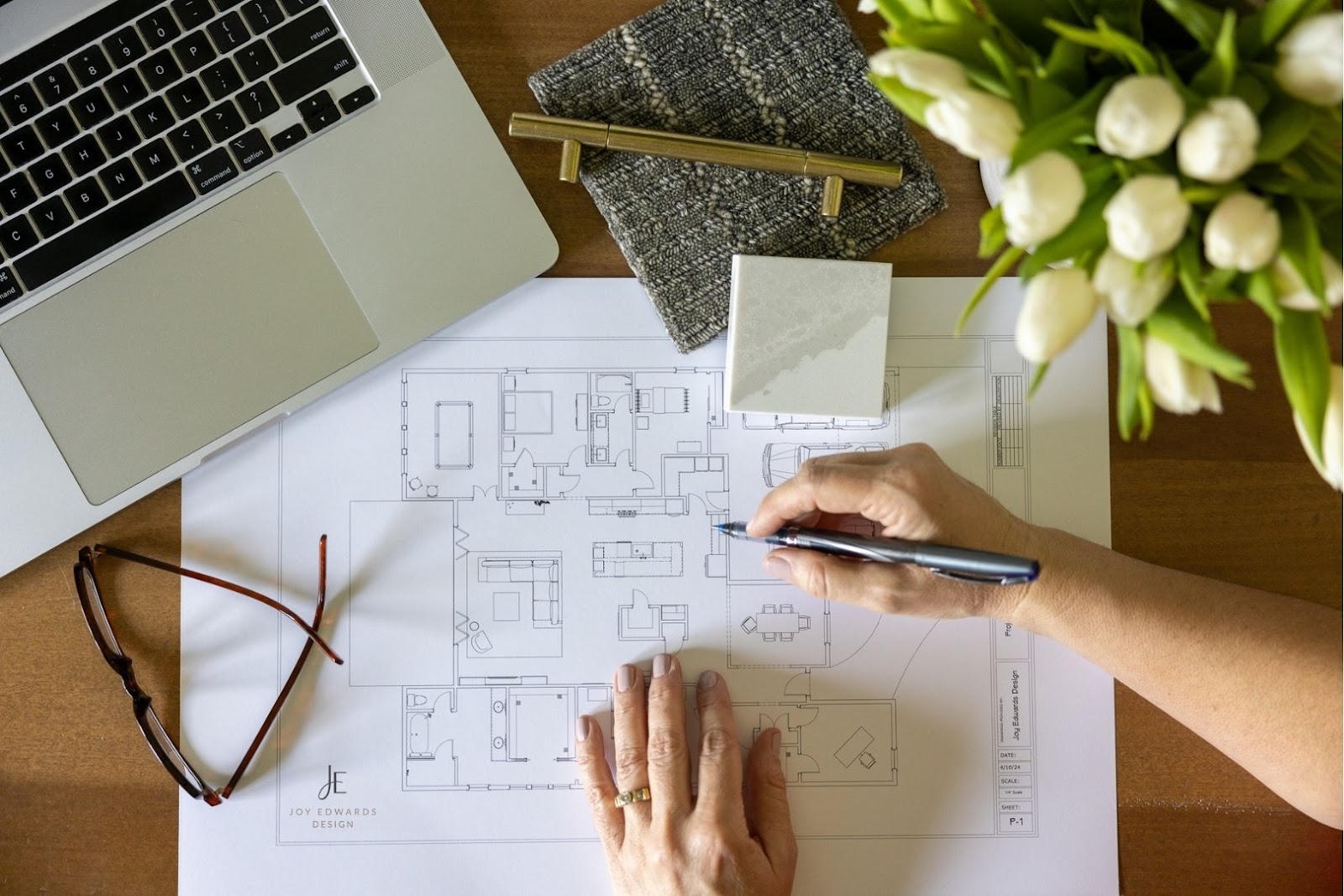
Beginning a large-scale project requires a solid foundation, both in design and planning. Whether you’re renovating, adding an addition, or building from the ground up, the key to a successful outcome lies in hiring the right professionals at the right time.
Understanding the proper sequence for your project and the distinct roles of a contractor, interior designer, and architect can make all the difference. Without that clarity from the start, it’s easy to head down the wrong path, leading to costly frustrations, inefficiencies, and unnecessary rework before your construction has even started.
One of the most important, and often overlooked questions I wish more homeowners would ask during a discovery call is: “Who should I hire first - a designer, a builder, or an architect?
Too often, I find that clients have already hired a contractor and are now feeling stuck because they aren’t getting what they need during the critical planning stage of the design process. In my 10+ years as an interior designer in Northern Virginia, I’ve found that the answer to who to hire first depends on several key factors, most importantly, what you are trying to achieve with your home.
Every project requires a contractor or builder, and depending on the scope, it should also include an architect, an interior designer, or both. General contractors manage the construction, like framing walls, running plumbing and electrical, coordinating trades, and overseeing the physical execution of your project. In contrast, architects and interior designers focus on the design vision—space planning, layout, aesthetics, materials, and how the space functions—ensuring that what gets built aligns beautifully with your goals and lifestyle.
Many homeowners assume a general contractor is the first person they should hire. But, hiring them before your vision is clearly defined can lead to costly changes, inefficient decisions, and missed opportunities to elevate your space.
Here’s why:
If you hire a contractor first, they can give you a rough estimate based on similar projects they’ve completed. At this stage, you likely haven’t finalized the layout, selected materials, or made decisions about cabinetry, millwork, or lighting. Without a designer or architect guiding those selections and providing detailed plans, those decisions often fall to you.
Once your selections are made and plans are finalized, the contractor usually comes back with a revised, and often higher, price based on the final plans since all the details weren’t filled in initially. At this point, construction may be ready to begin, leaving you to make rushed decisions if you didn’t work everything out in advance. You may feel pressured to meet the contractor’s timeline, potentially missing opportunities to optimize your space or facing costly change orders just to get the results you want.
The truth is, in order to get an accurate estimate from a contractor, your design needs to come first. Without detailed plans, a contractor is simply guessing. While they may help troubleshoot layout or feasibility, their expertise is in executing a design - not creating one.
That’s why it’s better to hire an interior designer, and possibly an architect, before you bring on a contractor.

If you are planning a new build, addition, or extensive renovation, hiring a licensed architect is a wise investment. Architects specialize in the design and structure of buildings, ensuring they not only look beautiful but are also safe, code-compliant, and thoughtfully laid out. Hiring an architect first sets your project on the right path. It helps prevent costly changes midstream by establishing a clear and cohesive plan from the outset.
During the planning and design process, your architect can:
- Design the overall layout, structure, and exterior of your home or addition
- Create permit-ready architectural drawings and construction documents
- Determine structural feasibility and cost effectiveness
- Ensure compliance with codes and zoning requirements
- Collaborate with engineers, designers, and contractors
- Oversee the design intent during construction if hired for construction administration
Architects often manage the design phase and frequently collaborate with designers, as designers are responsible for a wider range of interior finishes. Once you reach the stage of reviewing plans and making decisions about materials, it is advisable to bring an interior designer on board.
When your renovation focuses primarily on the interior layout, finishes, and functionality of your space, rather than significant structural changes. In that case, an interior designer is often the best professional to hire first.
You should hire an interior designer instead of an architect when:
- You’re reimagining the layout of a kitchen, bathroom, or living space
- You’re updating finishes like cabinetry, tile, flooring, lighting, and paint
- You need help selecting fixtures, furnishings, or built-ins
- You want to improve the flow, function, or overall feel of your home
- You’re looking for a cohesive, beautiful design that reflects your style
Interior designers are experts in space planning, finish selections, and interior functionality. They often collaborate with architects or engineers when structural changes are needed. Still, for many renovations, a designer is the key professional who brings vision, clarity, and cohesion to your space.
At Joy Edwards Design, we specialize in space planning and layout optimization, helping clients uncover the full potential of their homes. We lead the design process and collaborate with architects or engineers when structural changes are required. When done right, a design-first approach creates a clear roadmap for your project, making sure every decision supports a cohesive and elevated final result.
During the design process, I support my clients by:
- Creating floor plans, elevation drawings, and renderings to ensure spacing and movement through a space is optimal
- Creating cabinetry design to build out a kitchen or bathroom
- Creating furniture plans to identify the right sized pieces for your space and addressing situations that need to be adjusted before construction begins
- Selecting cabinetry, flooring, tile design, wall finishes, lighting and plumbing fixtures throughout the space
- Preparing installation details for the contractor
- Developing the lighting plan and ensuring switches and outlets are placed not only to meet code, but to provide optimal lighting and convenience based on the proposed furniture layouts we created
As an interior designer, I carefully consider all the details to create a home that reflects your aesthetic and supports your everyday needs. My role is to translate your vision into clear, actionable documents through floor plans, elevation drawings, specification sheets, and on-site coordination so your builder or contractor knows exactly how to implement the design.
Whether your project requires an architect or just an interior designer, the goal remains the same: to ensure that every element works together seamlessly for a cohesive, functional, and beautifully finished home.

Now that your plans are finalized and all key decisions are in place, it’s time to begin the process of selecting a contractor. The contractor will review the design drawings and material selections prepared by your architect and/or designer and use them to develop an accurate project estimate. This process becomes significantly more efficient when all design details are clearly documented and well organized.
Contractors will typically include allowances, placeholders for materials not yet selected, alongside a proposed construction schedule. If you’re collecting multiple bids, you’ll be in a better position to make an informed comparison when each contractor is working from the same comprehensive set of plans.
At Joy Edwards Design, we also offer construction bidding services. We obtain two to three bids for a client, determine quality and workmanship, and then present them to the client to make the final decision. Most architects are also able to help guide clients in the right direction to choosing a reputable builder who does quality work.
As an interior designer, I work closely with contractors throughout construction to ensure the design is executed as intended and to troubleshoot any issues that arise. I also review allowances to make sure they align with the client’s expectations for quality. Oftentimes, I need to inform clients of unrealistically low allowances that don’t reflect the level of finish they truly desire. By catching these early, I help eliminate costly surprises down the road.
Sometimes, homeowners reach out to a designer later in the process after key decisions have already been made. While some designers will still help at that stage, the impact of what they are able to provide will be more limited. When you bring a designer on at the beginning, everything can be planned to work together perfectly - from layout and materials to lighting and furnishings.
At Joy Edwards Design, we’ll help you make informed decisions, prioritize where to splurge, and think through details you might not have considered.
If you’re planning a renovation, addition, or new build, I’d love to help—just fill out a Project Inquiry Form to get started!